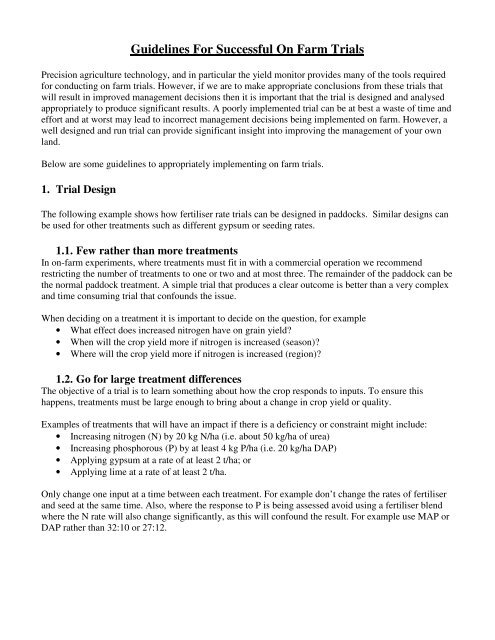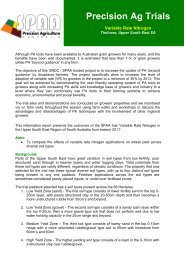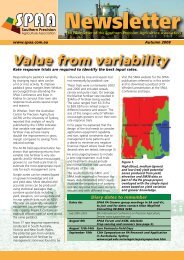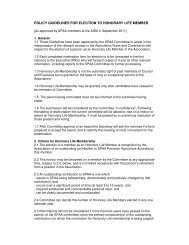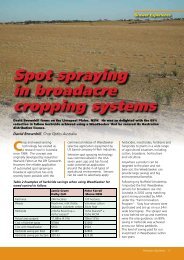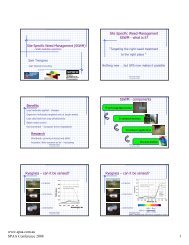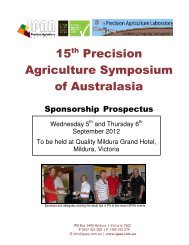Guidelines For Successful On Farm Trials - SPAA
Guidelines For Successful On Farm Trials - SPAA
Guidelines For Successful On Farm Trials - SPAA
- No tags were found...
Create successful ePaper yourself
Turn your PDF publications into a flip-book with our unique Google optimized e-Paper software.
2. Additional information for on farm trialsIn addition to applying the trial treatments and harvesting the final yield results, additional informationmay also help to explain why or why not a yield response occurs. This additional information mayinclude visual observations, soil tests, plant nutrient analysis, N-rich strips, grain nutrient analysis, plantcounts and weed counts.2.1. Soil Sampling for Phosphorous, Salinity and pH within zones• Target soil samples within zones that have been defined for your paddock, these zones may bebased on the compilation of yield maps, EM38, biomass imagery or some other relevant layer.Alternatively, base the sampling on your own knowledge of the paddock and your feel for thedifference in production across the paddock. We can still zone the paddock after it is sampled andlocate the sample sites in the relevant zones afterwards.• Take samples from points located with a GPS.• Sample between 2-4 sites in each zone, depending on the size of the paddock and the relative sizeof each zone.• Take 10-15 samples at each point to a depth of 10cm. Sample in an area up to 30m across. Use aconsistent method for sampling the row and inter-row, for example if the crop row is 5cm with25cm row spacings, then take 1 in 5 cores from on the previous crop row.• <strong>For</strong> each zone samples can be either bulked or analysed individually. Bulking samples for eachzone reduces the cost of soil testing. However, analysing each sample separately gives anindication of how much variability is within the defined zones and may indicate whether the zonesare accurate or not.• Mix thoroughly and sub sample 100-150g (bit less than a cup full) for each sample to be analysed.If soil is moist allow to dry in open bag. We use plastic zip lock bags.• Use a code system to label samples using grower initials and a number.Eg ST1, ST2, … Record location of each sample.• <strong>For</strong> trials assessing P response have the phosphorous buffering index analysed in addition toColwell P. Save an additional 100g of soil and this can be sent to the University of Adelaide for aDGT analysis.2.2. Soil sampling for available Nitrogen (nitrate and ammonia) and sulphateSulphur• Follow a similar protocol as for phosphorous above. Take cores to a depth of 60cm.• Take 2 cores at each location rather than 10-15, within a couple metres of each other to get arepresentative sample for that point.• <strong>For</strong> each zone samples can be either bulked or analysed individually. Bulking samples for eachzone reduces the cost of soil testing. However, analysing each sample separately gives anindication of how much variability is within the defined zones and may indicate whether the zonesare accurate or not.• Mix the entire core thoroughly and sub sample 120-150g soil. Alternatively the cores can besegmented into depth layers, e.g. 0-30cm and 30-60cm to give a better indication of where the Nis in the profile. Testing for sodicity, salinity and pH within these segments may also indicate thepresence of sub soil constraints that may affect the availability of N at lower depths.
2.5. Plant and weed countsIt may be useful to do crop plant and weed counts in trials that are assessing variable rate seeding.<strong>For</strong> crop plant counts• Count crop plant emergence 4-6 weeks after sowing at 8-10 locations within each treatment andwithin each zone to determine the actual population attained from the seed rates applied.• Count crop head number prior to harvest at 8-10 locations within each treatment and within eachzone.• Use a 1m length stick, place between two crop rows and count the plants or heads in the two rows.• Record the row widths to calculate plant density.<strong>For</strong> weed counts• <strong>For</strong> trials assessing the competition affects of crop density on weeds, count weed head numberprior to harvest, this provides an indication of competition effects on potential weed seedproduction.• Use a 0.1m 2 quadrat or bigger.• Count head number at 15-20 locations within each treatment and within each weed patch. Weeddensity can be highly variable within a patch, therefore locate counts adjacent to one anotherbetween treatments and the more counts and replicates the better.3. AcknowledgementsThanks to Roger Lawes, CSIRO sustainable ecosystems and the GRDC for their contribution in puttingthis protocol together.


